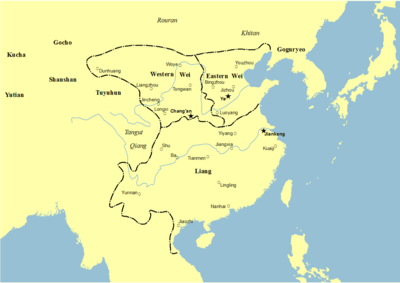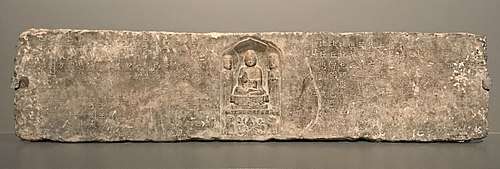Eastern Wei
The Eastern Wei (/weɪ/;[4] simplified Chinese: 东魏; traditional Chinese: 東魏; pinyin: Dōng Wèi) followed the disintegration of the Northern Wei, and ruled northern China from 534 to 550. As with Northern Wei, the ruling family of Eastern Wei were members of the Tuoba clan of the Xianbei.
Eastern Wei 東魏 | |||||||||
|---|---|---|---|---|---|---|---|---|---|
| 534–550 | |||||||||
 Eastern Wei and neighbors | |||||||||
| Capital | Luoyang (534) Yecheng (534–550) | ||||||||
| Government | Monarchy | ||||||||
| Emperor | |||||||||
• 534–550 | Emperor Xiaojing of Eastern Wei | ||||||||
| History | |||||||||
• Established | 8 November[1] 534 | ||||||||
• Disestablished | 7 June[2] 550 | ||||||||
| Area | |||||||||
| 550[3] | 1,000,000 km2 (390,000 sq mi) | ||||||||
| Currency | Chinese coin, Chinese cash | ||||||||
| |||||||||
| Today part of | China | ||||||||
In 534 Gao Huan, the potentate of the eastern half of what was Northern Wei territory following the disintegration of the Northern Wei dynasty installed Yuan Shanjian a descendant of the Northern Wei as ruler of Eastern Wei. Yuan Shanjian was a puppet ruler as the real power lay in the hands of Gao Huan. Several military campaigns were launched against the neighboring Western Wei in an attempt to reunify the territory once held by the Northern Wei, however these campaigns were not successful, and in 547 Gao Huan died. His sons Gao Cheng and Gao Yang were able to pursue his policy of controlling the emperor, but in 550 Gao Yang deposed Yuan Shanjian and founded his own dynasty, the Northern Qi.
Art

The Buddhist art of the Eastern Wei displays a combination of Greco-Buddhist influences from Gandhara and Central Asia (representations of flying figures holding wreaths, Greek-style folds of the drapery), together with Chinese artistic influences.

References
Citations
- Zizhi Tongjian, vol. 156.
- Zizhi Tongjian, vol. 163.
- Rein Taagepera "Size and Duration of Empires: Growth-Decline Curves, 600 B.C. to 600 A.D.", Social Science History Vol. 3, 115-138 (1979)
- "Wei". Random House Webster's Unabridged Dictionary.
Sources
- Book of Wei
- History of Northern Dynasties
- Zizhi Tongjian